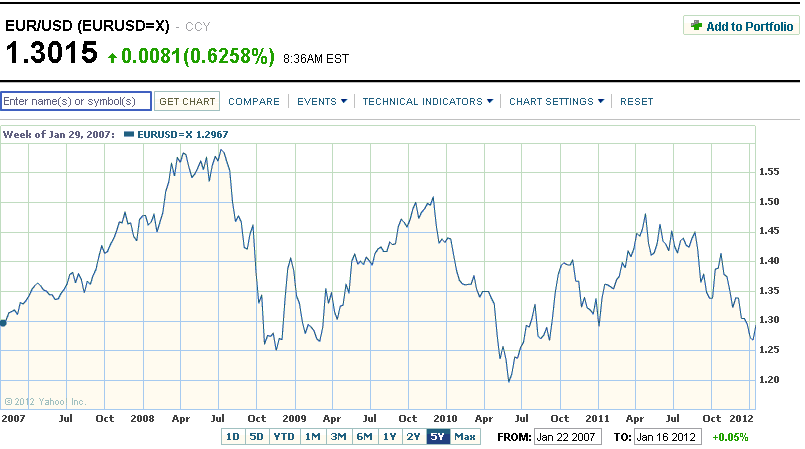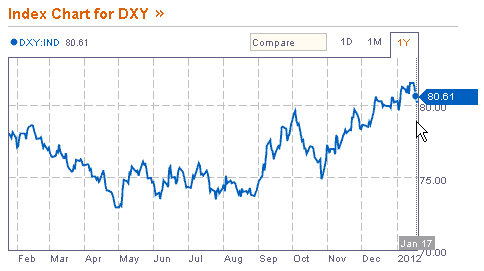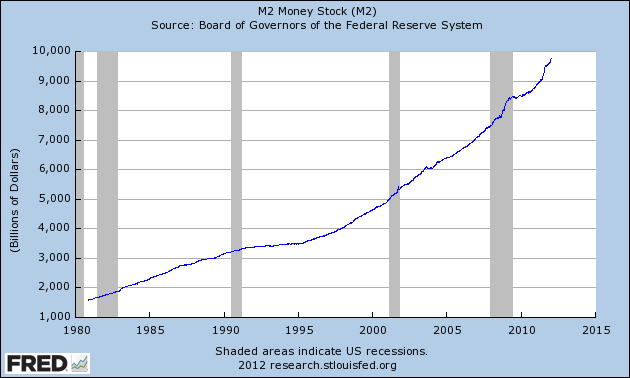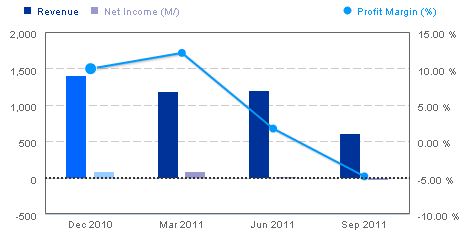How many times do you hear someone who sells gold and silver be dollar bullish? Probably not very often. But when you look at what the Dollar Index represents, a basket of other currencies, it’s quite easy to be dollar bullish right now. This doesn’t mean that the dollar is any stronger as far as it’s purchasing power mind you. It just means that it will be stronger versus the main currencies that it competes against; the euro and the yen, which make up 71.2% of the Dollar Index. It is the euro and the yen that are in deeper trouble than the dollar itself, at least over the short term. The dollar will have its day, but maybe not in the manner that many think it will, which I will explain.
2010 European Stress Tests: Fail
In July of 2010, they came out with a European Stress Test of the banks. I made a prediction at that time, where I speculated the results would come out positive even though I showed how the balance sheets of the major banks in each of the PIIGS (Portugal, Ireland, Italy, Greece and Spain) countries showed the opposite. This article will reanalyze these banks with the addition of Japanese banks and let readers know where the euro and yen are headed and by default, the U.S. dollar.
The euro at the time of the European stress test 1 1/2 years ago was trading at 1.2863. The stress tests revealed only 7 out of 91 European banks were found to be short of the required 6% Tier 1 capital needed. I remember CNBC’s Steve Leisman saying at the time that we were “making a mountain out of a mole hill.”
Since that time the euro, as seen in the chart below, proceeded to move to a high of 1.48. The ECB had fooled the people into thinking everything in Europe was just fine. But everything in Europe wasn’t just fine. The important point to remember here is that one can be right about things, but the Central Banks and market makers can take your money through influencing “perception” of the general public to put their money in the places they want them to, all the while knowing where things are eventually headed.
In other words, they were long the euro and took their profit and are now short because they knew what I pointed out in my article in 2010; the banks were in trouble. So what’s going on today? As you can see from the chart of the Euro above, the Euro has been in a downward trend since July of 2008, reaching a low of 119 in June of 2010, about the time of the European (fake) bank stress tests, and after heading up to 1.48 is now in a downward trend again because of all the issues that Greece, Portugal, Italy etc. are having. This fall in the euro of course has been dollar bullish as seen in the chart below. Why? Because the euro makes up 57.6% of the dollar.
As you can see from the chart of the Euro above, the Euro has been in a downward trend since July of 2008, reaching a low of 119 in June of 2010, about the time of the European (fake) bank stress tests, and after heading up to 1.48 is now in a downward trend again because of all the issues that Greece, Portugal, Italy etc. are having. This fall in the euro of course has been dollar bullish as seen in the chart below. Why? Because the euro makes up 57.6% of the dollar.
The U.S. Dollar Index® is computed using a trade-weighted geometric average of six currencies. The six currencies and their trade weights are:
euro 57.6 %
Japan/yen 13.6 %
UK/pound 11.9 %
Canada/dollar 9.1 %
Sweden/krona 4.2 %
Switzerland/franc 3.6 %
The yen, which makes up 13.6% of the dollar has had its glory days in the past as well. While I have been premature in my call for the fall of the yen, at 230% debt to GDP ratio, the highest in the civilized world, the yen’s glory days are numbered. The only thing keeping the yen going is government intervention and to a lesser extent the fact they are a net exporter and their citizens buy 98% of their Treasuries.
There will be a lot more of that rising debt to GDP ratio coming America’s way as the Japanese example has shown it can drag out the game for a while. But for now, especially being an election year, I don’t see too much more government spending. The Republicans can use it against Obama and this current administration knows it.
What Does the Future Fall of the Euro and Yen Mean?
What does the future fall of the euro and the yen mean? It means, as mentioned before, that 71.2% of the Dollar Index is declining and thus, by default, the dollar will rise. While gold and silver are still needed as insurance against future banking failures here in America, I believe the dominos will start falling in the Eurozone and Japan first. People can talk inflation and deflation all they want, but if the banks implode, real money is what’s needed, and that’s why I call gold and silver insurance.
I have been in the deflation camp all along during this credit contraction. The quantitative easing is just keeping the game going a little longer, but is not stimulating any real growth (See Japan), just temporary pockets of success, usually in the government related sectors (military industrial complex, green technology, infrastructure). These can hardly be called a success when they are funded by debt to begin with. Yes, inflation will come. There has to be repercussions to what we see with quantitative easing, TARP and the following chart of M2.
Euro Banking Analysis Revisited
I did an analysis of various European banks in my 2010 article. Below you will see how these same banks have done of late. Please note that European central bankers pumped nearly $640 billion into the Continent’s banking system. So much for the success of the stress test and CNBC’s Steve Leisman’s claim of “making a mountain out of a mole hill.” The Central Banks know how important it is to keep perception positive. They have a tremendous battle ahead of them.
ITALY
Intesa Sanpaolo Bank – Italy’s largest retail bank
The bank’s shares have been battered this year, shedding 45 percent of their value amid worries over its exposure to bad European government debt.
Italy's police seize 220 mln euro derivative contracts.
SPAIN
Banco Bilbao Vizcaya Argentaria (BBVA)
Shares of Banco Bilbao Vizcaya Argentaria Under Pressure, Down 2.0%
BBVA Takes $1.3 Billion Charge for U.S. Goodwill Adjustment
The European Banking Authority said Europe’s banks will need to raise 114.7 billion euros in fresh capital as part of measures introduced to respond to the sovereign debt crisis. The new figure is over 8 billion euros more than previously estimated by the EBA in October. Among lenders needing to bolster their reserves Banco Bilbao Vizcaya Argentaria SA (NYSE:BBVA), missed the target by 6.33 billion euros.
IRELAND
AIB – Allied Irish Banks
Total AIB Group – loss for 2010 was € 10.2 billion.
Allied Irish loss soars to $15 bln
Irish state-controlled banks Allied Irish Banks and permanent tsb are in advanced talks with officials about putting their loss-making tracker mortgages in off-balance sheet vehicles of the former Anglo Irish Bank. The former Anglo Irish Bank, renamed Irish Bank Resolution Corporation (IBRC), which is being wound down, has cost the state nearly 35 billion euros to keep afloat.
PORTUGAL
Banco Comercial Portugues
Currently facing a EUR1.725 billion shortfall has acknowledged they could be forced to tap a EUR12 billion line under Portugal’s EUR78 billion bailout to cover the gap.
Revenues:
GREECE
I didn’t mention Greece in my 2010 article and there is no reason to mention them this time. Their ship has already sailed and sunk.
Japanese Banks
From Reuters;
"BOJ Governor Masaaki Shirakawa, however, warned that Europe’s sovereign debt crisis remained the biggest threat to Japan’s recovery prospects, already clouded by recent yen rises against the euro and slowing global demand for Japanese goods. ”At present, Europe’s debt problem poses the biggest risk for the global economy, including Japan’s. If the situation worsens further, it may trigger a global credit crunch,” Shirakawa told a news conference after the BOJ’s widely expected decision to hold off on additional monetary easing."
"With interest rates virtually at zero, the central bank put in place in 2010 a pool of funds to buy assets ranging from government to public debt to pump cash into the economy and shield it from the pain from a strong yen."
"It last boosted the scheme in October last year and has been standing pat since then, but has expressed its readiness to ease again if Europe’s debt crisis and the market fallout threaten Japan’s recovery prospects. Many market players expect another expansion in its asset purchases by mid-year."
The Japanese government, to keep the game going as long as possible, with no success, is still trying to stimulate.
" Eager to pass bills through parliament to raise taxes to fix Japan’s tattered finances, the government kept up pressure on the central bank to help support the fragile economy."
“In order to overcome the yen’s rise to historical levels and prolonged deflation we will fortify cooperation with the BOJ … and manage solid economic and fiscal policies,” Prime Minister Yoshihiko Noda told parliament.
I’m not sure how raising taxes and BOJ injections are “solid economic and fiscal policies,” but let's look at the banks balance sheets to see what’s really going on.
Mitsubishi UFJ Financial Group
52 week stock return is -13.46%
Return on Equity 5 Yr. Avg: -1.13%
Sales %: -7.52
EPS %: -54.21
Debt has also risen since the 2008 crisis.
As weak as these financials are, what I found intriguing is Bank of Tokyo-Mitsubishi UFJ, a unit of Mitsubishi UFJ Financial Group Inc., is planning to domestically issue subordinated straight bonds for retail investors. What’s intriguing is the following statement where it says the bonds can’t be redeemed until the sixth year and beyond. In other words, loan us money so we can get through these trying times and we sure do hope to pay you back down the road:
"The bonds, which carry maturities of up to 10 years, can be redeemed from the sixth year and beyond. The bank will issue Y110 billion worth of the bonds, according to a document it submitted to the Finance Ministry."
Mizuho Financial Group
EPS – 5 Yr. Growth Rate: -24.36
Sales – 5 Yr. Growth Rate: -5.70
Stock price 52-Week Change: -25.49%
Net income is half of what it was last year.
Sumitomo Mitsui Financial Group, Inc
Net Income: -24.8%
Qtrly Revenue Growth (yoy): -8.80%
Qtrly Earnings Growth (yoy): -47.90%
Stock price 52-Week Change: -12.13%
This financial data doesn’t really scream BUY to me. What happens when interest rates rise? Will these banks be loaning more or less? If you are the owner of a bank today, do you really want to lock in a long term interest rate less than 5%? Too much risk.
While we don’t know exactly what Central Banks of the world are doing in propping up European, Asian and U.S. banks, we do know what happened in 2008 when they had to play catch up. But it was the U.S. dollar that people of the world ran to, even though our entire financial system was crashing. We also know, as far as the European banks go, the stress test of 2010 was a farce. When looking at what you can expect in the future, even though there might be short term manipulation to get you to think otherwise, look no further than the banks balance sheets. They tell the true picture.
The Ship Analogy
All currencies are on a ship. On one side we have the U.S. dollar and on the other side we have the euro, pound and yen as the big players. Investors such as OPEC spend time running from one side of the ship to the other, looking to maintain their purchasing power.
Right now investors are running to the U.S. side of the ship despite the last few days of euro strength. The euro is in trouble and soon the yen will be in trouble. This represents 71.2% of the U.S. dollar. What would you do if you were OPEC? They may say one thing as the U.S. and Iran play chicken with the nuclear issue, but it seems logical enough to me that they are betting on the U.S. dollar right now.
But all of these investors chasing these currencies back and forth need to know that this ship is sinking. All currencies are in a mad dash to become cheaper to make their products more attractive to overseas buyers so that these countries can export more goods in trying to help their own economies.
Investors don’t realize that this currency filled boat is taking on tons of water in the engine room. They don’t realize that the purchasing power of these currencies has been decreasing for the last decade. So while the U.S. dollar may be the current benefactor of the euro and yen decline, it too will eventually lose purchasing power. Investors need to turn to the lifeboat that gold and silver provide. No other investment has performed as well as gold and silver the last 11 years.
We’ve had a current upswing in the price of gold and sivler with the dollar's fall the last week or so. I am still thinking we get a stronger dollar based on the above analysis. This could, over the short term, still have an effect on gold and silver prices to the downside.
I have been waiting for that one last shake out in gold and silver. In my 2012 predictions article I said that I don’t see a terrible year for the stock market because it’s an election year. Obama will do all he can to prop up the stock market. This can’t be discounted. Republicans would love for the stock market to fall, but they don’t hold the reigns to the Federal Reserve horses. The March – April time-frame will dictate where we go. It was in March of 2008 that we saw gold and silver get hammered with a stronger dollar. If the euro does fall to the 118/ 119 level as I expect it to, the dollar will rise to the 88/89 level. The yen is the only wild card at this point and if it does finally begin to implode, it will push the Dollar Index up even more.
The ECB and IMF are trying to come to agreements as we speak with Greece. It has been a difficult situation for all involved. Greece is nothing compared to the other countries that are trying desperately to keep the status quo. They won’t be able to. This will be the big story of 2012. Not the U.S. dollar decimation as many other in the precious metals industry may claim. The dollar’s time will come. But for now, Treasuries are still strong and “perception” is the U.S. is still the last bastion of safety. Till it isn’t.
- English (UK)
- English (India)
- English (Canada)
- English (Australia)
- English (South Africa)
- English (Philippines)
- English (Nigeria)
- Deutsch
- Español (España)
- Español (México)
- Français
- Italiano
- Nederlands
- Português (Portugal)
- Polski
- Português (Brasil)
- Русский
- Türkçe
- العربية
- Ελληνικά
- Svenska
- Suomi
- עברית
- 日本語
- 한국어
- 简体中文
- 繁體中文
- Bahasa Indonesia
- Bahasa Melayu
- ไทย
- Tiếng Việt
- हिंदी
Here's Why I'm Dollar Bullish
Published 01/25/2012, 01:11 AM
Updated 07/09/2023, 06:31 AM
Here's Why I'm Dollar Bullish
3rd party Ad. Not an offer or recommendation by Investing.com. See disclosure here or
remove ads
.
Latest comments
Install Our App
Risk Disclosure: Trading in financial instruments and/or cryptocurrencies involves high risks including the risk of losing some, or all, of your investment amount, and may not be suitable for all investors. Prices of cryptocurrencies are extremely volatile and may be affected by external factors such as financial, regulatory or political events. Trading on margin increases the financial risks.
Before deciding to trade in financial instrument or cryptocurrencies you should be fully informed of the risks and costs associated with trading the financial markets, carefully consider your investment objectives, level of experience, and risk appetite, and seek professional advice where needed.
Fusion Media would like to remind you that the data contained in this website is not necessarily real-time nor accurate. The data and prices on the website are not necessarily provided by any market or exchange, but may be provided by market makers, and so prices may not be accurate and may differ from the actual price at any given market, meaning prices are indicative and not appropriate for trading purposes. Fusion Media and any provider of the data contained in this website will not accept liability for any loss or damage as a result of your trading, or your reliance on the information contained within this website.
It is prohibited to use, store, reproduce, display, modify, transmit or distribute the data contained in this website without the explicit prior written permission of Fusion Media and/or the data provider. All intellectual property rights are reserved by the providers and/or the exchange providing the data contained in this website.
Fusion Media may be compensated by the advertisers that appear on the website, based on your interaction with the advertisements or advertisers.
Before deciding to trade in financial instrument or cryptocurrencies you should be fully informed of the risks and costs associated with trading the financial markets, carefully consider your investment objectives, level of experience, and risk appetite, and seek professional advice where needed.
Fusion Media would like to remind you that the data contained in this website is not necessarily real-time nor accurate. The data and prices on the website are not necessarily provided by any market or exchange, but may be provided by market makers, and so prices may not be accurate and may differ from the actual price at any given market, meaning prices are indicative and not appropriate for trading purposes. Fusion Media and any provider of the data contained in this website will not accept liability for any loss or damage as a result of your trading, or your reliance on the information contained within this website.
It is prohibited to use, store, reproduce, display, modify, transmit or distribute the data contained in this website without the explicit prior written permission of Fusion Media and/or the data provider. All intellectual property rights are reserved by the providers and/or the exchange providing the data contained in this website.
Fusion Media may be compensated by the advertisers that appear on the website, based on your interaction with the advertisements or advertisers.
© 2007-2024 - Fusion Media Limited. All Rights Reserved.
